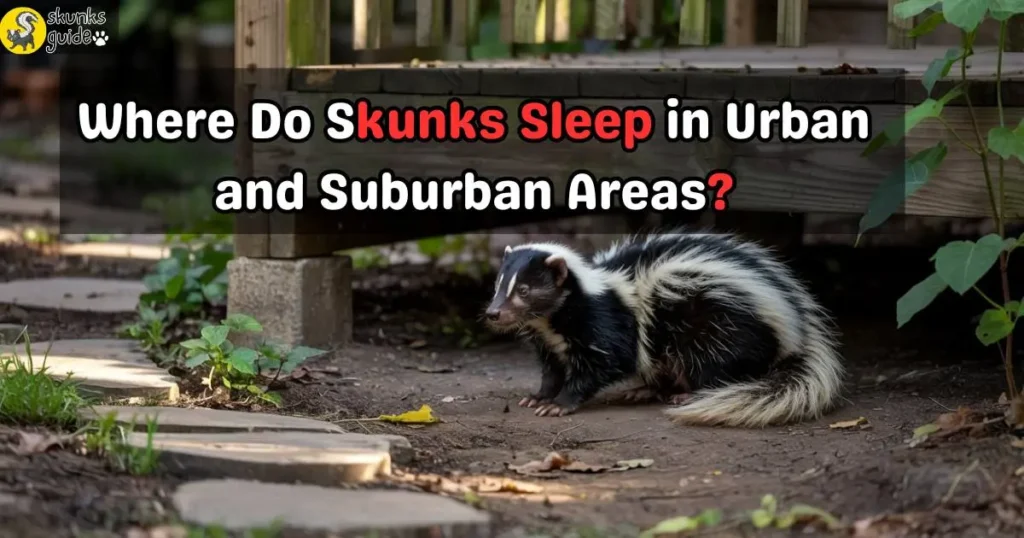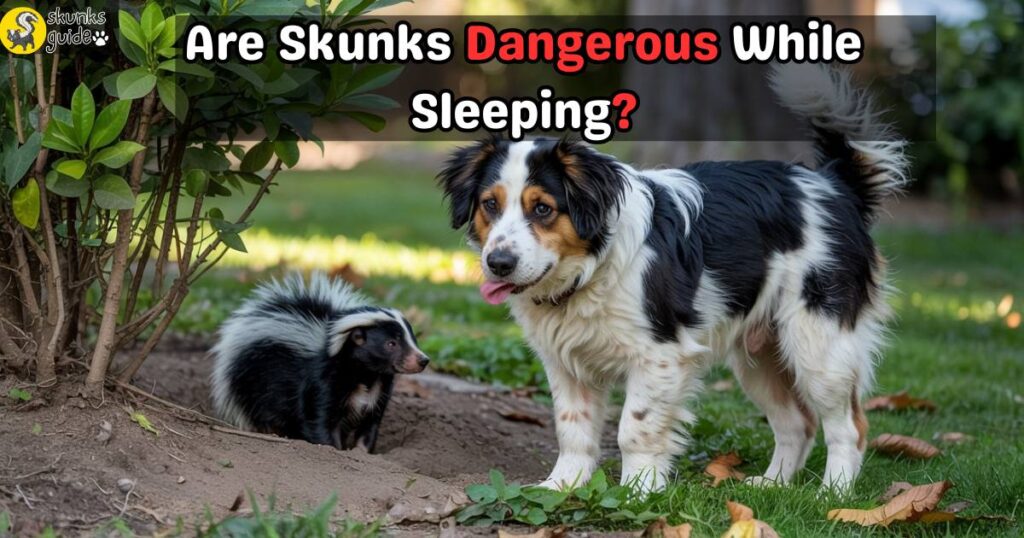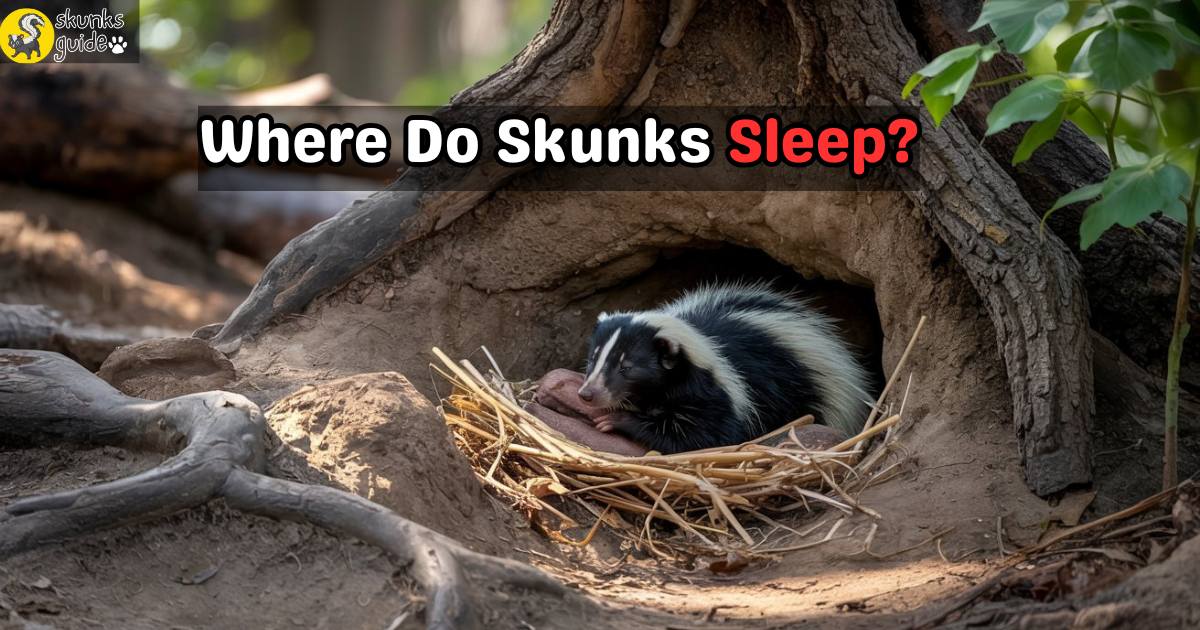Where Do Skunks Sleep? A Wildlife Expert Explains
Wondering where skunks sleep? As someone who’s spent years studying skunks in the wild and helping homeowners and pet owners peacefully coexist with these striped foragers, I get this question all the time.
Skunks sleep in dark, quiet, and secure dens—typically during the day—since they’re nocturnal. You’ll often find them napping under decks, sheds, porches, or inside burrows they’ve repurposed from other animals.
In this guide, I’ll break down everything you need to know about skunk sleeping habits, where they choose to rest, and how to protect your pets and home from accidental skunk encounters.
Do Skunks Sleep During the Day?
Yes—skunks are nocturnal, which means they are active at night and sleep during the day. While you might spot one occasionally out and about in daylight (especially if it’s a pregnant female or foraging after a storm), daytime skunk sightings are rare.
Here’s what their daily routine looks like:
- 🕓 Daylight hours: Sleeping, resting, grooming inside their den
- 🌙 Nighttime: Foraging for insects, small rodents, berries, or garbage
Skunks are surprisingly tidy creatures, often grooming themselves before bed—just like your cat might!
Where Do Skunks Sleep in the Wild?
Skunks aren’t picky, but they are strategic. They choose sleep spots that offer safety from predators and the elements.
Common skunk sleeping spots include:
- 🕳️ Abandoned animal burrows (like fox or groundhog dens)
- 🌲 Under dense brush or logs
- 🪵 Hollowed-out tree stumps
- 🪺 Tunnels dug into soft ground or near water sources
During the cold season, multiple skunks may share a den for warmth—a behavior known as communal denning—especially in colder northern regions.
Where Do Skunks Sleep in Urban and Suburban Areas?

Skunks adapt incredibly well to human environments. That means your yard might be a prime napping spot if it offers the right shelter.
Places skunks sleep around homes:
- Under porches or decks
- Beneath garden sheds or crawl spaces
- Inside woodpiles or compost heaps
- In rock piles or debris
- Inside open garages or barns
If you notice a skunky smell under your porch in the morning, chances are you’ve got a sleepy guest.
Why Do Skunks Choose These Spots?
Skunks don’t build complex dens. Instead, they prefer to reuse existing spaces that check off a few essential criteria:
| Den Feature | Why It Matters |
|---|---|
| Darkness | Mimics underground environment; reduces threat from predators |
| Shelter from elements | Protects from rain, wind, and snow |
| Low human or predator traffic | Reduces risk of danger |
| Soft ground or openings | Makes entry and nesting easier |
Female skunks, especially when pregnant, are extra cautious when selecting a den—often choosing hidden areas where they can raise their young (kits) in peace.
Are Skunks Dangerous While Sleeping?

Skunks are rarely aggressive unless they feel cornered or threatened. While not dangerous while sleeping, if you or your pet accidentally disturb one in its den, you might experience a smelly surprise.
Here’s what you need to know:
- 🐕 Are skunks dangerous to dogs?
Yes, if your dog disturbs a sleeping skunk, it may get sprayed. In rare cases, bites can occur. - 🐈 Are skunks dangerous to cats?
Less likely than dogs, but curious cats can also be sprayed or scratched. - 😷 Is skunk spray dangerous?
It’s not toxic, but it can cause eye irritation and nausea in pets and people.
Always approach suspected skunk den areas with caution—and preferably, don’t approach at all.
How Long Do Skunks Sleep?
On average, skunks sleep 12 to 14 hours per day, especially in colder months. During winter, some skunks enter a state of torpor—a temporary hibernation-like condition where their activity and metabolism drop significantly.
That said, skunks don’t fully hibernate, so they may still leave the den occasionally to forage.
Related Skunk Sleeping Info
| Question | Answer |
|---|---|
| Where do skunks sleep during the day? | Inside dens under decks, sheds, brush, or burrows |
| Do skunks sleep under houses? | Yes, especially in crawl spaces or vent openings |
| Do skunks hibernate? | No, but they may enter torpor in winter |
| Can skunks sleep in groups? | Yes, especially in cold months for warmth |
| When are skunks most active? | At night, from dusk to dawn |
Skunk Sleeping Habits FAQ
A: Skunks are shy by nature but will hiss, stomp, or spray if they feel trapped.
A: Rarely. Unlike raccoons, skunks are poor climbers and prefer the ground.
A: Signs include a musky odor, digging near foundations, or visible entry holes.
A: Not while occupied. Wait until the skunk has left for the night, then seal the entry. Better yet, contact humane wildlife removal.
Pet Safety and Prevention Tips
Worried about your pets getting skunked—or waking up a sleeping one? Here are some quick tips:
- 🗑 Secure trash bins and compost piles tightly
- 🐾 Supervise dogs when they’re outside, especially at dusk and dawn
- 🚫 Block access under porches, decks, or sheds with wire mesh
- 🥫 Don’t leave pet food or bowls outside overnight
- 📞 Call wildlife control if you suspect a den under your home
Final Thoughts from James Don
Skunks may get a bad rap for their spray, but these creatures are fascinating, gentle, and highly adaptable. By understanding where skunks sleep and how they behave, you can avoid conflicts and even appreciate their role in controlling insect populations around your home.
Whether you’re a homeowner, a pet owner, or just a wildlife enthusiast, knowing how to identify and manage skunk sleeping sites can keep your yard peaceful—and your nose safe.
Thanks for reading! For more skunk insights, pet safety tips, and wildlife facts, explore my other guides right here on SkunksGuide.com.

